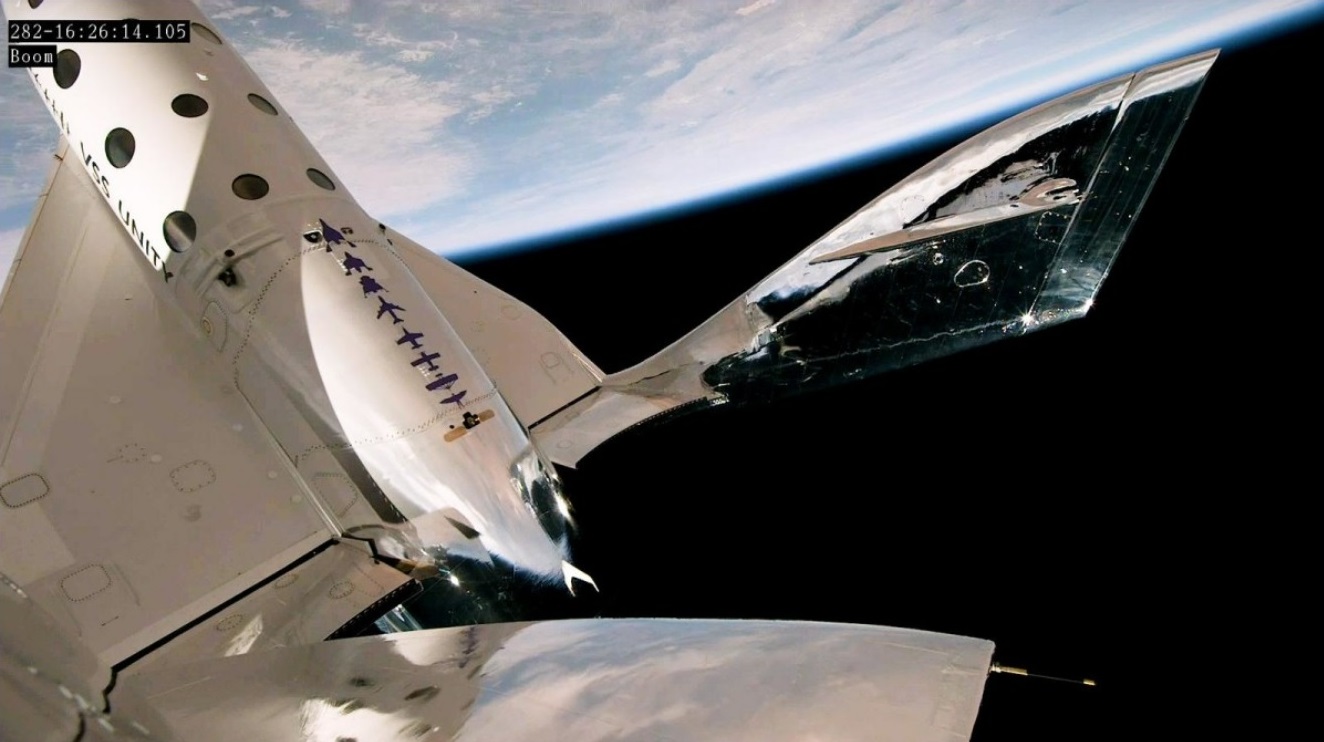After a two-year hiatus, Virgin Galactic’s SpaceShipTwo VSS Unity resumed flying crew members beyond a 50-mile-high space milestone, marking the end of a years-long flight test program and setting the stage for the start of commercial service as soon as next month.
It was the first launch of the Unity rocket plane from its VMS Eve carrier airplane since July 2021, when company founder Richard Branson took a ride. Branson said he was “proud” to be watching from Spaceport America in New Mexico when Unity took flight.
During today’s suborbital flight test, known as Unity 25, the rocket plane sent two pilots and four other Virgin Galactic employees to a maximum height of 54.2 miles, at a top speed of Mach 2.94.
Unity’s pilots were former NASA astronauts Mike Masucci and CJ Sturckow, and the other fliers were Jamila Gilbert, Christopher Huie, Luke Mays and Beth Moses.
Jameel Janjua and Nicola Pecile piloted the VMS Eve mothership, which took off from Spaceport America at 9:15 a.m. MDT (15:15 UTC) with Unity attached to its underbelly. A little more than an hour after takeoff, Eve released Unity at a height of 44,500 feet, clearing the way for the space plane to light up its hybrid rocket engine.
That rocket blast gave Unity’s crew members a few minutes of weightlessness and an astronaut’s-eye view of the curving Earth below the black sky of space. The top of their ride went beyond the 50-mile mark recognized by federal agencies and the U.S. military as the start of space, but stayed below the 62-mile (100-kilometer) line that marks the internationally recognized space boundary.
Unity glided back to a landing at Spaceport America at 10:37 a.m. MDT (16:37 UTC).
Based on post-flight reports, the crew didn’t quibble over how high they rose.
“Witnessing our inspiring crew’s pure joy upon landing, I have complete confidence in the unique astronaut experience we have built for our customers,” Virgin Galactic CEO Michael Colglazier said. “Our teams now begin post-flight analysis as well as preparation for ‘Galactic 01,’ our commercial research mission, planned for late June.”
Galactic 01 is set to fly three mission specialists from the Italian Air Force on a mission that’s designed to study the effects of the transition from normal gravity to microgravity on the human body. Other payloads will study the effect of the zero-G environment on chemical and physical processes.
Hundreds of customers have made reservations for trips to space at ticket prices amounting to as much as $450,000. Eventually, Virgin Galactic aims to have an entire fleet of rocket planes and carrier planes at Spaceport America to accommodate its customers.
Virgin Galactic’s journey to commercial service began nearly 20 years ago, when Branson licensed the SpaceShipOne aerospace technology that was used to win the $10 million Ansari X Prize in 2004.
The development effort faced multiple setbacks: Three workers were killed and three others were injured during ground testing in 2007. Seven years later, a SpaceShipTwo co-pilot died and the chief pilot was injured when their plane (known as VSS Enterprise) broke up in flight. It took two years to complete an investigation of the accident and make changes in the rocket plane’s design as well as in pilot procedures.
VSS Unity took on its first captive-carry flight in 2016 and its first rocket-powered flight beyond the 50-mile space milestone in 2018. After a follow-up flight in 2019, Virgin Galactic moved the test program’s base of operations from California’s Mojave Desert to New Mexico. The 2021 test flight that carried Branson and five other Virgin Galactic crew members to the edge of space came just nine days before rival billionaire Jeff Bezos took a suborbital space ride aboard a rocket ship built by his Blue Origin space venture.
After Branson’s trip, the Federal Aviation Administration temporarily suspended VSS Unity’s flights due to concerns about flight procedures. The suspension was lifted weeks later, but Virgin Galactic extended Unity’s downtime to conduct maintenance checks and make fixes. An unpowered glide test in April cleared the way for today’s Unity 25 mission.


If we nickname BO “Below Orbit” as its orbital plans continues to stink, VG would be so much “Below Space”.
I know which company I would buy a suborbital ticket on – if I can’t stand waiting for a cheaper Starship orbital ticket.